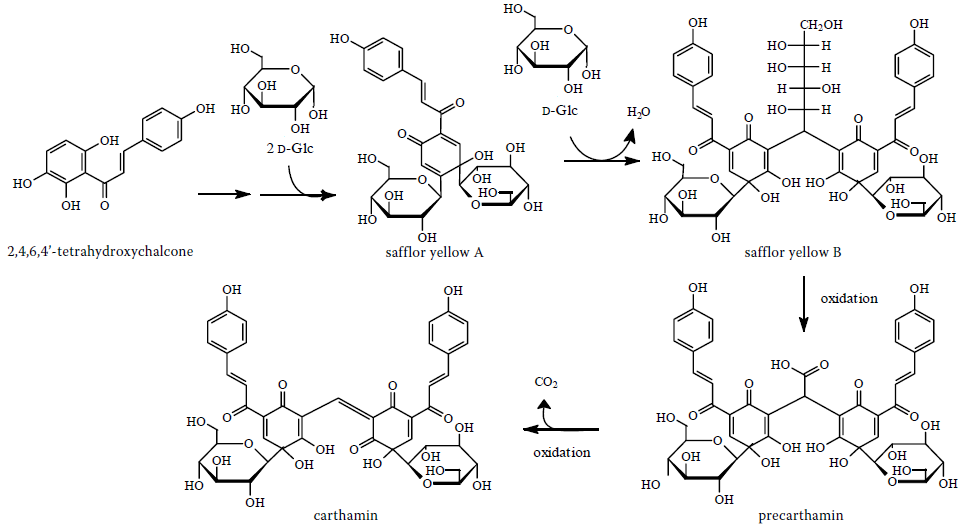Carthamin Proposed Biosynthesis on:
[Wikipedia]
[Google]
[Amazon]
Carthamin is a natural red pigment derived from safflower (''
''Origin of cultivated plants.''
D. Appleton & Co.: New York, p. 164. Retrieved on 2007-09-25. It is used as a dye and a food coloring. As a food additive, it is known as Natural Red 26. Safflower has been cultivated since ancient times, and carthamin was used as a dye in ancient Egypt. It was used extensively in the past for dyeing wool for the carpet industry in European countries, and in the dyeing of silk and the creation of cosmetics in Japan, where the color is called ; however, due to the expensive nature of the dye, Japanese safflower dyestuffs were sometimes diluted with other dyes, such as
Carthamus tinctorius
Safflower (''Carthamus tinctorius'') is a highly branched, herbaceous, thistle-like annual plant in the family Asteraceae. It is commercially cultivated for vegetable oil extracted from the seeds and was used by the early Spanish colonies alo ...
''), earlier known as carthamine.De Candolle, Alphonse. (1885.''Origin of cultivated plants.''
D. Appleton & Co.: New York, p. 164. Retrieved on 2007-09-25. It is used as a dye and a food coloring. As a food additive, it is known as Natural Red 26. Safflower has been cultivated since ancient times, and carthamin was used as a dye in ancient Egypt. It was used extensively in the past for dyeing wool for the carpet industry in European countries, and in the dyeing of silk and the creation of cosmetics in Japan, where the color is called ; however, due to the expensive nature of the dye, Japanese safflower dyestuffs were sometimes diluted with other dyes, such as
turmeric
Turmeric () is a flowering plant, ''Curcuma longa'' (), of the ginger family, Zingiberaceae, the rhizomes of which are used in cooking. The plant is a perennial, rhizomatous, herbaceous plant native to the Indian subcontinent and Southeast ...
and sappan
''Biancaea sappan'' is a species of flowering tree in the legume family, Fabaceae, that is native to tropical Asia. Common names in English include sappanwood and Indian redwood. Sappanwood is related to brazilwood (''Paubrasilia echinata''), ...
. It competed with the early synthetic dye fuchsine
Fuchsine (sometimes spelled fuchsin) or rosaniline hydrochloride is a magenta dye with chemical formula C20H19N3·HCl.
as a silk dye after fuchsine's 1859 discovery.
Carthamin is composed of two chalconoids; the conjugated bonds being the cause of the red color. It is derived from precarthamin by a decarboxylase. It should not be confused with carthamidin, another flavonoid.
The carthamin is biosynthesized from a chalcone ( 2,4,6,4'-tetrahydroxychalcone) and two glucose
Glucose is a simple sugar with the molecular formula . Glucose is overall the most abundant monosaccharide, a subcategory of carbohydrates. Glucose is mainly made by plants and most algae during photosynthesis from water and carbon dioxide, u ...
molecules to give safflor yellow A and with other glucose molecule, safflor yellow B. The next step is the formation of precarthamin and finally carthamin.

References